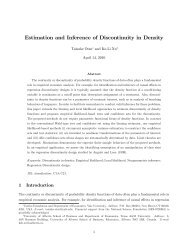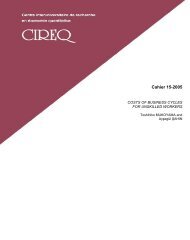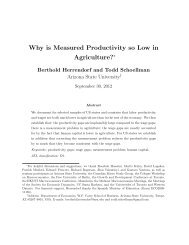contains at most one arc (i.e., ¯¯g+ i(ij)¯¯ ≤ 1). Let G+i⊂ P f (Ki + ) denote the collectionof all feasible i-sender networks. 8(iii) (Feasible Receiver Networks) A j-receiver network, gj − , is a nonempty closedsubset of j-receiver connections (i.e., gj − ∈ P f (Ki − )) such that (i) if (a, (i, j)) ∈ g− j ,then a ∈ A ij <strong>and</strong> (ii) for all nodes i ∈ N, thesectionofgj− at (i, j) given byogj na − (ij) := ∈ A ij :(a, (i, j)) ∈ gj−¯contains at most one arc (i.e., ¯gj − (ij)¯¯¯ ≤ 1). Let G−iof all feasible i-receiver networks.⊂ P f (K − i) denote the collectionNote that each feasible network G ∈ G is equal to the union of all its i-sendernetworks i := 1, 2 ...,m, <strong>and</strong> conversely. In particular,G := © ∪ i∈N g + i: g + i∈ G + ifor all i ª .Alternatively, each feasible network G ∈ G is equal to the union of all its j-receivernetworks j := 1, 2 ...,m, <strong>and</strong> conversely. In particular,noG := ∪ j∈N gj − : gj − ∈ G − jfor all j .For G ∈ G, rather than write G = ∪ i gi + , we will sometimes write G := (g+ i ,g+ −i ).9Note that for any sequence of networks, {G n } n in G converging to G 0 ∈ G, wehaveh K (G n ,G 0 ) → 0 if <strong>and</strong> only if P i h K(gi +n ,gi +0 ) → 0 where G n =(g 1 +n ,g+n 2 ,...,g+n m )for all n <strong>and</strong> G 0 =(g 1 +0 ,g+0 2 ,...,g+0 m ).For each player i ∈ N, letP i denote the set of all probability measures withsupport contained in the set of i-sender networks, G + i. The set of probability measureson G + iis a convex, w ∗ -compact <strong>and</strong> metrizable subset of ca i , the set of all bounded,countably additive signed measures on G + i ,whereca i is the separable norm dualof the separable Banach space, C(G + i ,R), of real-valued, h K-continuous functionsdefined on G + i .8 Under our definition of a directed network, in any given network G ∈ G some node pairs, (i, j),may not be connected at all (i.e., (a, (i, j)) /∈ G for all a ∈ A ij). This means that for any givennode i, there may not be a sender connection from i to any other node - <strong>and</strong> thus node i 0 s senderconnections may not be representable by an m-tuple (i.e., a tuple of fixed length m). Here, ourdefinition identifies a network with the graph of its representing function. In particular, thinking ofa directed network G as a function from ordered node pairs N × N into arcs A, sayγ G : N × N → A,we note that as we move through the set of networks, G, the domain <strong>and</strong> range of the function γ Grepresenting the network G may vary <strong>and</strong> in particular, the domain may not be equal to all of N ×N.Thus, for such a set of networks - because the domain varies across networks - it is not possible torepresent the sender connections from any particular node i to all other nodes by a tuple of fixedlength m.9 Alternatively, every feasible network, G ∈ G can be written as G = ∪ jg − j , or adopting ournotational convention for i-sender networks, we can also write G := (g − j ,g− −j ).14
In this example, let the ith player’s strategy set be given by P i with typicalelement μ i (i.e., X i := P i ). We will refer to the probability measure μ i ∈ P i as ar<strong>and</strong>om i-sender network (i.e., each player’s strategy is to choose a r<strong>and</strong>om sendernetwork which in turn determines the realized i-sender network g i ∈ G + iaccording tothe probability measure μ i ). We note that μ i is definedontheBorelσ-field, B(G + i ),in G + igenerated by the h K -open sets.Next letP := P 1 ×···×P mbe the compact metric space of product probability measures defined on the productσ-field, B(G 1 ) ×···×B(G m ), with typical elementμ = μ 1 ×···×μ m .We note that μ ∈ P has support contained in G. We will refer to μ ∈ P as a r<strong>and</strong>omnetwork.Taking P as the parameter space, we can think of the parameter μ e := (μ e i , μe −i ) ∈P, as players’ consensus probability beliefs concerning the likelihood with which variousnetworks might emergence in equilibrium (i.e., Z := P). We will assume that eachplayer’s feasible set of r<strong>and</strong>om networks is given by a w ∗ -continuous correspondence,Φ i (·) :P −i → P w ∗ fc(P i ),from consensus probability beliefs into the collection of all nonempty, w ∗ -closed, <strong>and</strong>convex subsets of r<strong>and</strong>om i-sender networks, denoted by P w ∗ fc(P i ).Thus, Z = X = P, satisfying [A-1](2) <strong>and</strong> (3) - <strong>and</strong> thus by Theorem 4, Z <strong>and</strong>X are dendrites.2.7 Descriptive Summary of Main ResultsLet {G z : z ∈ Z} be any parameterized collection of strategic form games satisfyingassumptions [A-1]. Under [A-1] for each parameter value (or externality value) z ∈ Z,the corresponding strategic form game, G z , has a nonempty, compact subset of Nashequilibria, N (z). Our main objective is to show that the Nash correspondence, z →N (z), is approximable. Because the Nash correspondence may have nonconvex - <strong>and</strong>possibly disconnected - values, the problem is difficult <strong>and</strong> requires a new approach(again see De Blasi <strong>and</strong> Myjak, 1986, for an extensive summary of results on thegraphical approximation of convex-valued correspondences by continuous functions).Here is a descriptive summary of our results, assuming [A-1] throughout. In ourdescription we will use the terms USCO <strong>and</strong> CUSCO. An USCO is an upper semicontinuous,set-valued mapping with nonempty, compact values, while a CUSCO is anupper semicontinuous, set-valued mapping with nonempty, compact <strong>and</strong> connectedvalues (e.g., see Hola <strong>and</strong> Holy, 2009).(1) (Properties of Nash Correspondences) We show that the Nash USCO, N (·),is a composition of two USCOs: an USCO mapping Ky Fan sets into the collectionof sets of Nash equilibria (the KFC mapping) composed with an USCO mapping Z15
- Page 5: cally approximated by continuous fu
- Page 12 and 13: the set x 0 x 1 ∈ C w ∗ f(X) is
- Page 14 and 15: defined on some probability space,
- Page 18 and 19: into the collection of Ky Fan sets
- Page 20 and 21: 3.1 Best Response MappingsLetting p
- Page 22 and 23: 4.1 Nikaido-Isoda FunctionsWith eac
- Page 24 and 25: Because Φ(z) × Φ(z) is w ∗ ×
- Page 26 and 27: where for all n, C n ∈ S E n,then
- Page 28 and 29: Definition 4 (The 3M Property - The
- Page 30 and 31: Given (48) and the fact that for n
- Page 32 and 33: We note that if m(z) ∈ P w ∗ f(
- Page 34 and 35: 6.3 AK Convergence of Minimal Nash
- Page 36 and 37: and Gr ρZ ×w ∗f ∗ (·) is the
- Page 38 and 39: In particular, for all n ≥ N 0 an
- Page 40 and 41: the cutting defined by the cut poin
- Page 42 and 43: According to our main result, under
- Page 44 and 45: By our main approximation result, f
- Page 46 and 47: 9 Appendix 1: USCO FundamentalsIn t
- Page 48 and 49: 9.3 Equi-QuasicontinuityIn order to
- Page 50 and 51: 9.5 Dense SelectionsFor each F ∈
- Page 52 and 53: 10 Appendix 2: The Proof of Lemma 8
- Page 54 and 55: Noting that if E ∈ D eE ,thenn eE
- Page 56 and 57: 12 Appendix 4: The Proof That All K
- Page 58 and 59: Letting E 1 =[E 1 \(X × U 2 )] ∪
- Page 60 and 61: [10] Bryant, V. W. (1970) “The Co
- Page 62: [42] Ward, L. E., Jr. (1958) “A F






